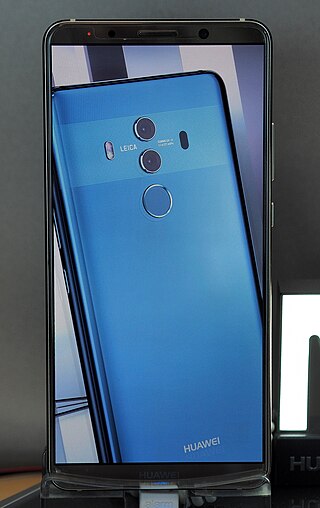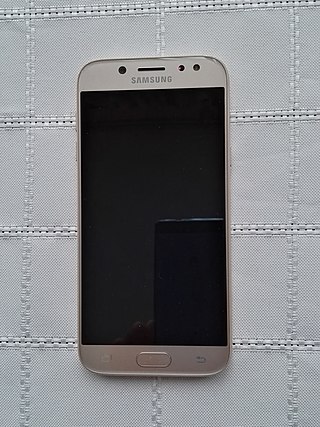Related Research Articles
Pantech Inc. is a South Korean company that manufactures mobile phones. Established in 1991, its market is mainly domestic with partners in the United States, Japan, China, Europe and Vietnam. In 2012 Pantech was the second best-selling handset maker in South Korea, according to Gartner. In 2013 Samsung Electronics bought a 10% stake in Pantech. Pantech also partners with PCD for specialized phones.
Huawei Premia 4G M931 is an Android smartphone offered by MetroPCS. Huawei Premia 4G M931 features Android 4.0
The HTC Desire 620 is an Android-based smartphone designed and manufactured by HTC. It is part of the Desire range of mid-range handsets. It was announced on 29 November 2014 in Taiwan. It was announced for the European market on 9 December 2014.
The Xiaomi Redmi Note Prime is a smartphone released in December 2015 in India, developed by the Chinese company Xiaomi Inc. It is a part of the Redmi Note series of smartphones, and succeeded the Redmi Note 4G. Visually similar to its predecessor, it comes with a 5.5-inch screen, a quad-core 1.2 GHz Qualcomm Snapdragon 410 processor and runs MIUI 7 based on Android 4.4, which can be upgraded to MIUI 9 based on.
The Huawei Mate 9 is a high-end Android smartphone, designed and produced by Huawei as part of the Huawei Mate series. It was released on 3 November 2016. It was succeeded by the Huawei Mate 10 series, and later the Huawei Mate 20 series.

The Huawei G8 is an upper mid-range Android smartphone designed and produced by the company Huawei. It was released on 2 September 2015.

The Samsung Galaxy J7 Prime is an Android-based smartphone produced and marketed by Samsung Electronics. It was unveiled in August 31, 2016 and released the month after. It was the first J series smartphone to feature an aluminium metal chassis alongside the Galaxy J5 Prime. The new smartphone included several new features that had never been used before on a phone. For example, the phone featured split screen application modes.

The Huawei Mate 10, Huawei Mate 10 Pro and Huawei Mate 10 Lite are Android smartphones designed and marketed by Huawei as part of the Huawei Mate series. There is also a Mate 10 Porsche design, which has 256 GB of storage but is otherwise identical to the Mate 10 Pro. They were first released on 16 October 2017. Versus the predecessor Mate 9, the Mate 10 pro flagship phone has a faster processor with an integrated neural processing unit, a slightly larger OLED screen (6.0") with a taller 18:9 aspect ratio, a significantly longer battery life and a glass back construction. Chinese and international models are available in dual SIM configuration. It comes with Android 8 and a newer version of Huawei's EMUI interface. All Mate 10 models are unlocked and GSM only. Huawei phones, including the Mate series, are not sold or financed through U.S. carriers due to pressure from U.S. intelligence agencies, though they are available from independent and online retailers.

Redmi 3 was an Android smartphone manufactured by Xiaomi released in January 2016. It had 5-inch HD IPS LCD, and was powered by Qualcomm's Snapdragon 1.2GHz octa-core Qualcomm Snapdragon 616 processor, paired with 2GB of RAM. It runs on the Android operating system and is equipped with a non-removable 4100mAh battery.

Samsung Galaxy J5 2017 is an Android-based smartphone produced, released and marketed by Samsung Electronics. It was unveiled and released in July 2017 along with the Samsung Galaxy J3 (2017). It has an advanced 64-bit class system on a chip (SoC) backed by 2 GB or 3 GB Of LPDDR3 RAM. It packs a Non-removable 3000 mAh battery. The Galaxy J5 (2017) is the successor to the Samsung Galaxy J5 (2016).

Huawei Mate 20 is a line of Android phablets produced by Huawei, which collectively succeed the Mate 10 as part of the Huawei Mate series. The flagship models, the Mate 20 and Mate 20 Pro, were unveiled on 20 July 2018 at a press conference in London.

The Honor 8x is a smartphone made by Huawei under their Honor sub-brand. It is a successor of the Huawei Honor 7x within the Huawei Honor series.

The Samsung Galaxy A40 is a mid-range Android smartphone developed and manufactured by Samsung Electronics. Running on the Samsung's Android 11-based One UI 3 software, the device was announced on March 19, 2019. It was released a month later in Europe on April 10, 2019.
The Nokia C1 is a Nokia-branded budget smartphone released by HMD Global, running the Android Go variant of Android. The phone supports 3G network speed and was announced on December 11, 2019.

The Samsung Galaxy A32 is a mid-range Android smartphone developed and manufactured by Samsung Electronics. It serves as the successor to the Galaxy A31. The phone is similar to its predecessor, but features an upgraded 64 MP main camera. The device also comes with a 5G variant with a stripped-down camera and screen, but with a faster SoC.

The Samsung Galaxy A23 is an Android-based smartphone designed, developed and marketed by Samsung Electronics as a part of its Galaxy A series. The phone was announced on March 4, 2022, alongside the Galaxy A13.
The Samsung Galaxy A10s is an Android-based smartphone developed and marketed by Samsung Electronics as a part of its Galaxy A series. This phone was announced on August 27, 2019, and was targeted towards the low-budget category. It is the second Galaxy smartphone not manufactured by Samsung and was instead manufactured by Jiaxing Yongrui Electron Technology. Unlike the first ODM Galaxy smartphone, the China-exclusive Samsung Galaxy A6s, it is available internationally.
The Huawei Y3 (2017) is an Android smartphone from the Huawei Y series developed by Huawei. It was introduced by in June 2017 and later released in September 2017.

The Huawei Y5 (2017) is an Android smartphone from the Y series manufactured and developed by Huawei. It was announced in April 2017, and was released in June.
The Huawei Y6 (2017) is an Android smartphone from the Y series manufactured and developed by Huawei. In China, it was announced and released under the name Honor 6 Play developed by Honor - a subsidiary of Huawei.
References
- 1 2 "Huawei Y5 Prime (2018) - Full phone specifications". www.gsmarena.com. Archived from the original on October 24, 2021. Retrieved 2018-12-17.
- ↑ "Huawei Y5 2018 — бюджетный смартфон с флагманскими функциями". gagadget.com (in Russian). Archived from the original on January 13, 2021. Retrieved 2021-01-10.
- 1 2 3 Andreychuk, Maksim. "Обзор смартфонов Huawei Y5 2018 и Y6 Prime 2018". ITC.ua (in Russian). Archived from the original on December 18, 2018. Retrieved 2018-12-17.
- ↑ "HUAWEI Y5 2018 | Смартфони | HUAWEI Україна". consumer.huawei.com. Archived from the original on December 18, 2018. Retrieved 2018-12-16.
- ↑ "≡ Смартфон Huawei Y5 2018 (DRA-L21) Dual Sim Black – купить в Киеве | цены и отзывы". www.moyo.ua (in Russian). Archived from the original on December 18, 2018. Retrieved 2018-12-16.
- ↑ "Huawei Y5 2018 Blue". rozetka. Archived from the original on December 18, 2018. Retrieved 2018-12-16.
